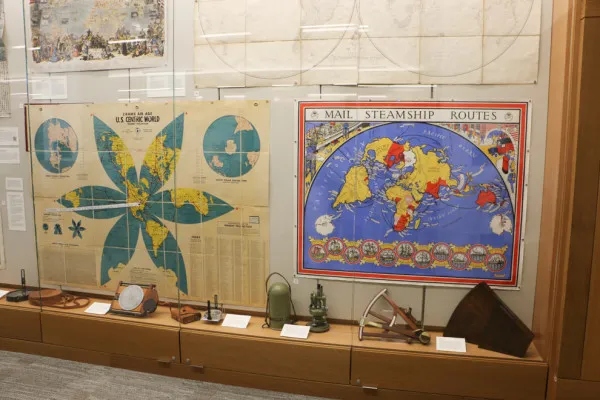Last week, the David Rumsey Map Center opened in Green Library, unveiling a new collection of 150,000 pieces donated by David Rumsey to Stanford Libraries.
The collection, amassed by the retired real-estate developer and longtime collector over more than 40 years, features a wide range of artifacts, from atlases to globes to children’s maps, and spans the whole Earth, focusing in particular on North and South America. With the Rumsey maps, the new center builds on maps from other donors, Stanford’s Special Collections and the Branner Earth Sciences Library to create a wealth of resources that Stanford Libraries calls “unparalleled on the West Coast.”
The Rumsey collection is not only large but unusually accessible — a characteristic that was important to Rumsey when he chose Stanford to host his maps.
“In the past, these kinds of collections were more about preservation, which is good, very admirable,” Rumsey told KQED. “But we would like to change that paradigm.”
The entire Rumsey collection will be available online as part of Stanford Libraries’ Cartographic Digital Philanthropy Program. The program — whose phrase “digital philanthropy” was coined by Rumsey himself — makes personal collections widely available to viewers in digital form, allowing them to visualize cartography with geospatial mapping technology.

“The center addresses one of the key concerns of historians in the computer age: How are we going to make sure key materials survive?” said Karen Wigen, Frances and Charles Field Professor of History.
Each piece in the collection was scanned and put in an online database equipped with special tools for analysis. For example, one can overlay maps of the same location from different time periods and compare side-by-side how cartographers understood the world around them in the past and present.
Technology is also important to the physical Center in Green. Its fourth-floor room in the Bing Wing features two massive iPad-like touch screens, one 12- by 7-foot and one 16- by 19-foot, that allow visitors to zoom in and examine maps in minute detail.
During last week’s opening events, Rumsey, head and curator of the Center G. Salim Mohammed, consulting associate professor of engineering Paul Saffo J.D. ’80 and other staff demonstrated an array of technology at the Center’s disposal, from the aforementioned giant screens to iPads to the virtual reality tool Oculus Rift.
“Over time the map center will become a place not only about history but also about the history of technology,” Rumsey told The Daily.
Both David Rumsey and his wife Abby Rumsey, who was at last Tuesday’s packed grand opening, emphasized what the center has to offer for students.
“What I hope Stanford students will be able to take away from the center is an understanding of the power of exploration,” Abby Rumsey said. “Maps have a lot of things only discovered by close analysis. They have a denser level of information that can help you understand broader concepts.”
“We’re hoping that students will define how they might use the center,” David Rumsey added.
The center and its opening exhibit “A Universe of Maps,” which runs through August, took over five years of planning by Mohammed in collaboration with Rumsey.
“[Rumsey] is the world’s most involved donor,” Mohammed said of the partnership between Rumsey and Stanford Libraries.
The fruits of this extensive planning were on display throughout last week, as the center celebrated its opening with two days of talks from center staff and scholars at Stanford and other universities.
Many at Stanford already engaged in map-related work shared their enthusiasm during the Center’s festivities. At a presentation by Stanford’s Center for Spatial and Textual Analysis (CESTA), which encompasses a variety of research projects in the digital humanities, multiple researchers described how maps and spatial data had opened up new angles of inquiry whether they were investigating the development of the Grand Canyon or fictional portrayals of London.
Richard White, Margaret Byrne Professor of American History, also spoke of maps’ ability to enhance learning.
“Using both maps and spatial data allowed me to do some of the best teaching I’ve ever done in my life,” he said.
The Center is open for viewing from 1 to 5 p.m. on weekdays to both Stanford community members and the public. Visitors must request materials in advance.
Hannah Knowles contributed to this report.
Contact Sandra Ortellado at sortella ‘at’ stanford.edu.
